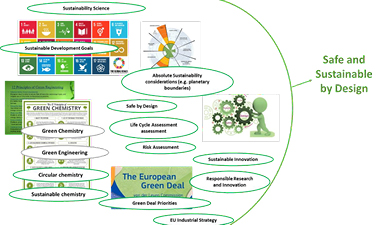Driving Safer Chemicals Through Alternatives Assessment
Monika A. Roy, Joel A. Tickner, UMass, Lowell; Michelle Bloor, University of Glasgow; Annegaike Leopold, ibacon GmbH
Many of the chemicals used to make consumer products, run industrial processes and support infrastructure have hazardous properties and may be harmful to humans and the environment. These impacts can occur during production, use and at end of life, and are often not successfully controlled with traditional risk management measures. Increasing scientific evidence has led to calls from consumers, investors, market leaders and others to eliminate hazardous chemicals from products and processes. However, removing chemicals of concern from products or processes without considering what will replace them can lead to regrettable substitutions, where a chemical of concern is replaced with a chemical of equal or potentially greater concern.
To identify and analyze alternatives to chemicals of concern, alternatives assessment has emerged as a science policy approach that, according to the US National Research Council Framework to Guide Selection of Chemical Alternatives, identify and compare potential chemical and non-chemical alternatives that could replace chemicals of concern on the basis of their hazards, performance and economic viability more systematically. In contrast to a risk assessment, an alternatives assessment is designed to identify the safer option(s) by comparing the pros and cons of potential chemical replacements before eliminating the chemical of concern, rather than establishing a level of safety. The starting point of an alternatives assessment is to understand the function of a chemical in the process or product, whether that function is necessary, and to understand the chemical and non-chemical alternatives to fulfill that function, often referred to as functional substitution. Where safer alternatives are not currently available, they may need to be developed.
The field has grown significantly over the past two decades, with efforts to build resources, such as the OECD Substitution and Alternatives Toolbox (SAAToolbox). Alternatives assessment has now emerged globally as a multisector community of practice, fostered by the Association for the Advancement of Alternatives Assessment (A4). Further information about the alternatives assessment, its origins and ongoing challenges can be found in the new SETAC Technical Issue Paper, “Chemical Alternatives Assessment,” in addition to other resources on alternatives assessment hosted by SETAC.
In the literature, there are many case examples of the way in which alternatives assessment has been applied in a variety of contexts e.g., sectoral, government and individual companies to support the transition to safer chemicals. Each case is unique, and depends on the chemical of concern, the application for which it is used, the components of the alternatives assessment being used to conduct the assessment (e.g., beyond hazard assessment, performance, and economics), and the available resources that determine the degree of detail to which the assessment can be carried out. For instance, Northwest Green Chemistry published an alternatives assessment for copper-containing anti-fouling coatings in 2017 to assess a range of alternatives to replace copper coatings in boat craft. The hazards, exposure, performance, cost and availability for about 20 different alternatives were compared, including for non-coating alternatives such as ultrasound technologies. A range of stakeholders were engaged in the process, improving the discussion around the tradeoffs of each alternative. The researchers concluded that some of the non-copper products were available on the market and comparable in terms of price and performance. A similar assessment and stakeholder engagement process was undertaken by the Dutch Government and the Lowell Center for Sustainable Production in 2018.
Alternatives assessment has been incorporated into a number of US state policies and in the authorization process under REACH for over a decade. However, the need for alternatives assessment is increasingly coming into focus with the European Green Deal and the Chemicals Strategy for Sustainability (CSS), which aims to advance a zero-pollution goal by addressing the whole production cycle of chemicals and all the steps that are involved in synthesizing them. Policy proposals will put increasing emphasis on phasing out the most harmful substances to both reduce risks and improve safe and sustainable circularity of materials. An important part of the CSS is the Safe and Sustainable by Design (SSbD) framework established to guide Research and Development and chemical sourcing decisions. SSbD goes far beyond a safety assessment to include a broad range of sustainability attributes such as how raw materials involved in the production are sourced, etc. Alternatives assessment will play a key role in supporting the CSS, evolving the method to thoughtfully address a broader range of sustainability attributes, and supporting informed decision-making without leading to paralysis by analysis.
Alternatives assessment will play a critical role in identifying safer, more sustainable options to chemicals or chemical classes slated for restriction and phase out, including for identified chemical functions and/or whole classes of chemicals such as for per- and polyfluoroalkyl substances (PFAS), which have been proposed for restriction in the EU. In addition to improving approaches for evaluating alternatives, there will be a need for enhanced approaches to support companies and government agencies in both developing and adopting safer options to achieve substitution goals.
Author’s contact: [email protected]






